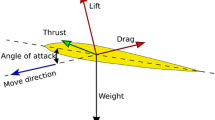Abstract
The roughness increase on horizontal axis wind turbine (HAWT) blade surface, especially on the leading edge, can lead to an aerodynamic performance degradation of blade and power output loss of HAWT, so roughness sensitivity is an important factor for the HAWT blade design. However, there is no criterion for evaluating roughness sensitivity of blade currently. In this paper, the performance influences of airfoil aerodynamic parameters were analyzed by the blade element momentum (BEM) method and 1.5 MW wind turbine blade. It showed that airfoil lift coefficient was the key parameter to the power output and axial thrust of HAWT. Moreover, the evaluation indicators of roughness sensitivity for the different spanwise airfoils of the pitch-regulated HAWT blade were proposed. Those respectively were the lift-to-drag ratio and lift coefficient without feedback system, the maximum lift-to-drag ratio and design lift coefficient with feedback system for the airfoils at outboard section of blade, and lift coefficient without feedback, maximum lift coefficient with feedback for the airfoils at other sections under the pitch-fixed and variable-speed operation. It is not necessary to consider the roughness when HWAT can be regulated to the rated power output by the pitch-regulated and invariable-speed operation.
Similar content being viewed by others
References
Molly J P. Wind Energy—Theory, Application, Measuring. 2nd ed. Karlsrube: Verlag C F M, 1996
Corten G P, Veldkamp H F. Insects can halve wind-turbine power. Nature, 2001, 412: 42–43
Corten G P, Veldkamp H F. Insects cause double stall. In: European Wind Energy Conference, Copenhagen, Denmark, 2001
Khalfallaha M G, Koliub A M. Effect of dust on the performance of wind turbines. Desalination, 2007, 209: 209–220
Dalili N, Edrisy A, Carriveau R. A review of surface engineering issues critical to wind turbine performance. Renewable and Sustainable Energy Rev, 2009, 13: 428–438
Yang K, Wang H S, Xu J Z, et al. Optimization and design method research of wind turbine airfoils based on CFD technique (in Chinese). J EngThermophys, 2007, 28(4): 586–588
van Rooij R P J O M, Timmer W A. Roughness sensitivity considerations for thick rotor blade airfoils. J Solar Energy Eng, 2003, 125(4): 468–478
Ramsay R R, Hoffmann M J, Gregorek G M. Effects of grit roughness and pitch oscillations on the S809 airfoil. Technical Report NREL/TP-442-7817. Golden: National Renewable Energy Laboratory, 1995
Dahl K S, Fuglsang P. Design of the wind turbine airfoil family RISØ-A-XX. RisØ-R-1024(EN). Roskilde: RisØ National Laboratory, 1998
He D X. Wind Engineering and Industrial Aerodynamics (in Chinese). Beijing: National Defense Industry Press, 2006
Chen K, He D X, Dai Y Y, et al. Optimization and design on aerodynamic profile of 1.5MW/40.3m blade (in Chinese). In: 7th Annual Meeting of National Wind Energy Application Technology & Symposium of Wind Energy Development and Utilization in Qinghai Province and Other Altiplano Regions. Xining, Qinghai, 2010
Author information
Authors and Affiliations
Corresponding author
Rights and permissions
About this article
Cite this article
Huang, C., Yang, K., Liu, Q. et al. A study on performance influences of airfoil aerodynamic parameters and evaluation indicators for the roughness sensitivity on wind turbine blade. Sci. China Technol. Sci. 54, 2993–2998 (2011). https://doi.org/10.1007/s11431-011-4557-z
Received:
Accepted:
Published:
Issue Date:
DOI: https://doi.org/10.1007/s11431-011-4557-z




